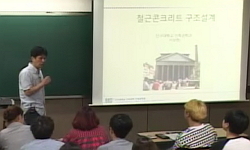In general, the cause of slab cracking during heat treatment has been analyzed with focus on processing conditions. However, in the present work, the cause of cracking is analyzed based on the microstructural evolution during heat treatment. The micro...
http://chineseinput.net/에서 pinyin(병음)방식으로 중국어를 변환할 수 있습니다.
변환된 중국어를 복사하여 사용하시면 됩니다.
- 中文 을 입력하시려면 zhongwen을 입력하시고 space를누르시면됩니다.
- 北京 을 입력하시려면 beijing을 입력하시고 space를 누르시면 됩니다.
https://www.riss.kr/link?id=A106885876
- 저자
- 발행기관
- 학술지명
- 권호사항
-
발행연도
2020
-
작성언어
Korean
- 주제어
-
등재정보
KCI등재
-
자료형태
학술저널
- 발행기관 URL
-
수록면
151-156(6쪽)
-
KCI 피인용횟수
0
- DOI식별코드
- 제공처
- 소장기관
-
0
상세조회 -
0
다운로드
부가정보
다국어 초록 (Multilingual Abstract)
In general, the cause of slab cracking during heat treatment has been analyzed with focus on processing conditions. However, in the present work, the cause of cracking is analyzed based on the microstructural evolution during heat treatment. The microstructural analysis indicates that the structure of the slab consists of three main regions as the top, quarter, and center parts. The tensile properties are investigated in each region of the slab in the temperature range from 25 to 350 °C. Results demonstrate that the cracking is mainly attributed to the thermal stress and specific morphology of the microstructure. It is proposed that the cracking during the heat treatment is related to the presence of inclusion at the ferrite phase which is located at the boundary of pearlite grains.
참고문헌 (Reference)
1 Y. Maehara, "The precipitation of A1N and NbC and the hot ductility of low carbon steels" 62 (62): 109-119, 1984
2 B. Hadała, "The influence of thermal stresses and strand bending on surface defects formation in continuously cast strands" 56 (56): 367-378, 2011
3 H. Liu, "The Influence of Carbon Content and Cooling Rate on: The Toughness of MnMo-Ni Low-Alloy Steels" 247-252, 2015
4 Y. Maehara, "Surface cracking mechanism of continuously cast low carbon low alloy steel slabs" 6 (6): 793-806, 1990
5 L. Zhang, "State of the Art in Evaluation and Control of Steel Cleanliness" 43 (43): 271-291, 2003
6 M. Y. Kim, "Reheating Furnace"
7 K. S. Chapman, "Modeling and parametric studies of heat transfer in a direct-fired continuous reheating furnace" 22 (22): 513-521, 1991
8 R. Lagneborg, "Influence of Impurities on the Mechanical Properties of Steel" 6 : 347-356, 1977
9 L. Zhang, "Inclusion removal by bubble flotation in a continuous casting mold" 37 (37): 361-379, 2006
10 Y.M.Won, "Improvement of Semi-macro Segregation in Continous Cast Slabs by Soft Reduction" 40 (40): 2002
1 Y. Maehara, "The precipitation of A1N and NbC and the hot ductility of low carbon steels" 62 (62): 109-119, 1984
2 B. Hadała, "The influence of thermal stresses and strand bending on surface defects formation in continuously cast strands" 56 (56): 367-378, 2011
3 H. Liu, "The Influence of Carbon Content and Cooling Rate on: The Toughness of MnMo-Ni Low-Alloy Steels" 247-252, 2015
4 Y. Maehara, "Surface cracking mechanism of continuously cast low carbon low alloy steel slabs" 6 (6): 793-806, 1990
5 L. Zhang, "State of the Art in Evaluation and Control of Steel Cleanliness" 43 (43): 271-291, 2003
6 M. Y. Kim, "Reheating Furnace"
7 K. S. Chapman, "Modeling and parametric studies of heat transfer in a direct-fired continuous reheating furnace" 22 (22): 513-521, 1991
8 R. Lagneborg, "Influence of Impurities on the Mechanical Properties of Steel" 6 : 347-356, 1977
9 L. Zhang, "Inclusion removal by bubble flotation in a continuous casting mold" 37 (37): 361-379, 2006
10 Y.M.Won, "Improvement of Semi-macro Segregation in Continous Cast Slabs by Soft Reduction" 40 (40): 2002
11 F. N. Rhines, "Furnace" 2 (2): 27-, 1981
12 R. H. Ralemi, "Cleavage fracture assessment of cold charged steel slabs using experimental and numerical approaches" 13 : 775-780, 2018
13 M. Itabashi, "Carbon content effect on high-strain-rate tensile properties for carbon steels" 24 (24): 117-131, 2000
14 S.Y. Kim, "Automatic Measuring System Development of Slab Inner Crack and Center Segregation" 5 : 332-334, 2009
15 Z. Liu, "An Experimental Benchmark of Non-metallic Inclusion Distribution Inside a Heavy ContinuousCasting Slab" 50 (50): 1370-1379, 2019
동일학술지(권/호) 다른 논문
-
알루미늄 단결정 집합조직이 AAO의 나노기공 구조에 미치는 영향
- 한국소성∙가공학회
- 박병현
- 2020
- KCI등재
-
FCC계 고엔트로피 합금의 냉간 인발 유한요소해석 및 실험적 검증
- 한국소성∙가공학회
- 조한솔
- 2020
- KCI등재
-
개량 Al-6.5Si 합금의 미세조직, 인장 및 충격 인성에 미치는 합금 원소 첨가의 영향
- 한국소성∙가공학회
- 박태현
- 2020
- KCI등재
-
전체면 접촉 절삭공구를 이용한 장구형 웜나사 치형가공 연구
- 한국소성∙가공학회
- 강신준
- 2020
- KCI등재
분석정보
인용정보 인용지수 설명보기
학술지 이력
| 연월일 | 이력구분 | 이력상세 | 등재구분 |
|---|---|---|---|
| 2026 | 평가예정 | 재인증평가 신청대상 (재인증) | |
| 2020-01-01 | 평가 | 등재학술지 유지 (재인증) |  |
| 2017-01-01 | 평가 | 등재학술지 유지 (계속평가) |  |
| 2013-01-01 | 평가 | 등재학술지 유지 (등재유지) |  |
| 2010-01-01 | 평가 | 등재 1차 FAIL (등재유지) |  |
| 2008-01-01 | 평가 | 등재학술지 유지 (등재유지) |  |
| 2006-01-01 | 평가 | 등재학술지 유지 (등재유지) |  |
| 2004-01-01 | 평가 | 등재학술지 유지 (등재유지) |  |
| 2001-01-01 | 평가 | 등재학술지 선정 (등재후보2차) |  |
| 1998-07-01 | 평가 | 등재후보학술지 선정 (신규평가) |  |
학술지 인용정보
| 기준연도 | WOS-KCI 통합IF(2년) | KCIF(2년) | KCIF(3년) |
|---|---|---|---|
| 2016 | 0.22 | 0.22 | 0.25 |
| KCIF(4년) | KCIF(5년) | 중심성지수(3년) | 즉시성지수 |
| 0.22 | 0.2 | 0.478 | 0.07 |




 ScienceON
ScienceON DBpia
DBpia




